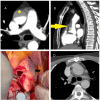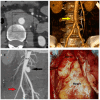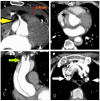A Narrative Review of Biomarkers and Imaging in the Diagnosis of Acute Aortic Syndrome
- PMID: 39857067
- PMCID: PMC11765216
- DOI: 10.3390/diagnostics15020183
A Narrative Review of Biomarkers and Imaging in the Diagnosis of Acute Aortic Syndrome
Abstract
Acute aortic syndrome (AAS) encompasses a range of life-threatening conditions, including classical dissection, intramural hematoma, and penetrating aortic ulcer. Each of these conditions presents distinct clinical characteristics and carries the potential to progress to rupture. Because AAS can be asymptomatic or present with diverse symptoms, its diagnosis requires clinical evaluation, risk scoring, and biomarkers such as D-dimer (DD), C-reactive protein (CRP), homocysteine, natriuretic peptides (BNP), and imaging modalities like computed tomography (CT), magnetic resonance imaging (MRI), and echocardiography. While this review primarily focuses on widely used and clinically accessible biomarkers and imaging techniques, it also discusses alternative biomarkers proposed for diagnostic use. Although CT remains the gold standard for diagnosis, biomarkers facilitate rapid risk stratification, complementing imaging techniques. Emerging technologies, such as metabolomics, are reshaping diagnostic algorithms. Despite advances in diagnostic methods, challenges such as misdiagnosis and missed diagnoses persist. Ongoing research into novel biomarkers and innovative imaging techniques holds promise for improving diagnostic accuracy and patient outcomes.
Keywords: D-dimer; acute aortic syndrome; aortic dissection; artificial intelligence; biomarkers; computed tomography.
Conflict of interest statement
The authors declare no conflicts of interest.
Figures


















Similar articles
-
Diagnostic Accuracy of the Aortic Dissection Detection Risk Score Plus D-Dimer for Acute Aortic Syndromes: The ADvISED Prospective Multicenter Study.Circulation. 2018 Jan 16;137(3):250-258. doi: 10.1161/CIRCULATIONAHA.117.029457. Epub 2017 Oct 13. Circulation. 2018. PMID: 29030346
-
Imaging and Biomarkers in Acute Aortic Syndromes: Diagnostic and Prognostic Implications.Curr Probl Cardiol. 2021 Mar;46(3):100654. doi: 10.1016/j.cpcardiol.2020.100654. Epub 2020 Jul 22. Curr Probl Cardiol. 2021. PMID: 32958324 Review.
-
Multi-detector computed tomography in the diagnosis and management of acute aortic syndromes.World J Radiol. 2014 Jun 28;6(6):355-65. doi: 10.4329/wjr.v6.i6.355. World J Radiol. 2014. PMID: 24976936 Free PMC article. Review.
-
Imaging modalities for the early diagnosis of acute aortic syndrome.Nat Rev Cardiol. 2013 Aug;10(8):477-86. doi: 10.1038/nrcardio.2013.92. Epub 2013 Jun 25. Nat Rev Cardiol. 2013. PMID: 23797792 Review.
-
Recent advances in the diagnosis of acute aortic syndromes.Expert Opin Med Diagn. 2012 Nov;6(6):529-40. doi: 10.1517/17530059.2012.704362. Epub 2012 Jul 21. Expert Opin Med Diagn. 2012. PMID: 23480835
Cited by
-
Right Vertebral Artery Intermittent Flow Reversal Due to Innominate Artery Dissection.Diagnostics (Basel). 2025 Jun 30;15(13):1668. doi: 10.3390/diagnostics15131668. Diagnostics (Basel). 2025. PMID: 40647667 Free PMC article.
References
Publication types
LinkOut - more resources
Full Text Sources
Research Materials
Miscellaneous

